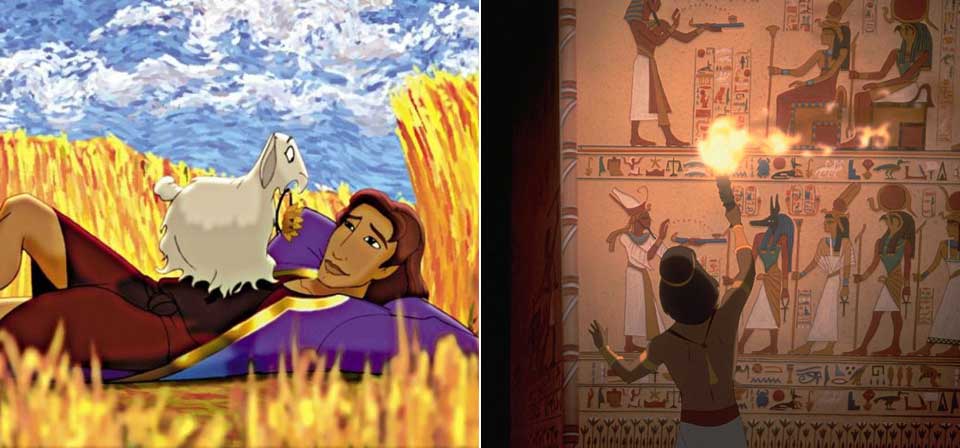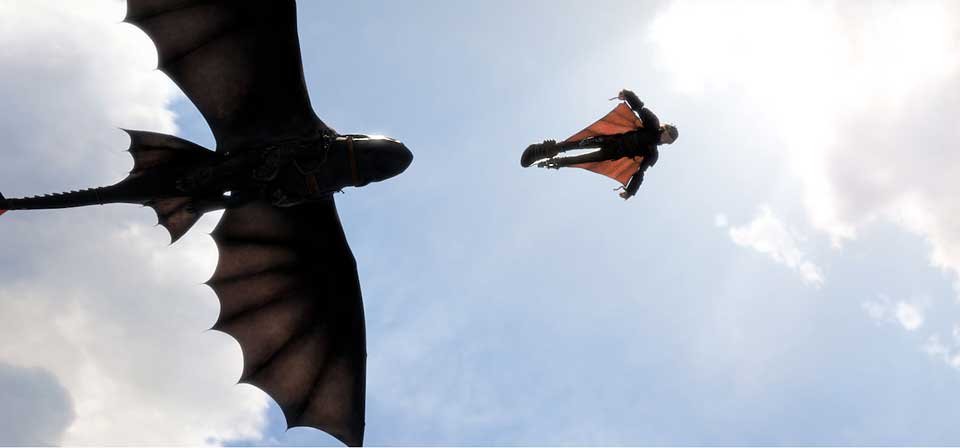Tags :: DreamWorks Animation

DreamWorks’ animated Torah
During the second week of Advent, as we’re wrapping up Genesis and turning to Exodus, our family viewing often includes DreamWorks’ two animated Pentateuch movies: the Exodus movie The Prince of Egypt and its made-for-TV prequel, Joseph: King of Dreams.
![Penguins of Madagascar [video]](/uploads/articles/penguins-of-madagascar.jpg)
Penguins of Madagascar [video] (2014)
Stick a fork in them, they’re done. Or maybe that’s just me.
So, how gay is How to Train Your Dragon?
“How to Train Your Dragon’s Gobber the Belch Comes Out As Gay,” headlines screamed in the weeks prior to the release of DreamWorks’ animated sequel How to Train Your Dragon 2.

How to Train Your Dragon 2 (2014)
The first film related how Hiccup changed his village’s way of life forever, winning the love of the girl of his dreams, the approval of his authoritarian father and the respect of everyone in town — not to mention the loyalty of his magnificent new draconian friend, Toothless. Where do you go from there?

Turbo (2013)
At some point, alas, it becomes apparent that Turbo’s more daring elements are all surface, and the story is locked into a well-worn path to an all-too-obvious destination. Writing about Monsters University, I noted that, like many other Pixar films, it pours cold water on the familiar family-film platitude that you can achieve anything you put your mind to if you just want it enough. Turbo embraces the platitude.
Madagascar 3: Europe’s Most Wanted (2012)
I blame the penguins for Madagascar 3: Europe’s Most Wanted.
Happy Feet Two (2011)
Little ones are “tougher than we think,” a penguin remarks in Happy Feet Two, and you can tell director George Miller believes it. The animated sequel pulls few punches: It’s overshadowed by more darkness, menace, heartache and anxiety than any talking-animal picture I can think of since, well, Miller’s last family-film sequel, the execrable Babe: Pig in the City. Neither the classic Babe nor the original Happy Feet contained any hint of the darkness of the sequels. Apparently Miller’s strategy is to soften kids up first, then drop the bomb.
Puss in Boots (2011)
Banderas’s swashbuckling Puss in Boots first appeared in Shrek 2, quickly establishing himself as one of the most popular supporting characters in the franchise. Now in a starring role in this spinoff, Puss spins the story in a direction strikingly different from the Shrek films.
Kung Fu Panda 2 (2011)
Returning screenwriters Jonathan Abel and Glenn Berger recognize that what’s needed is deeper emotions and darker themes as well as more action and higher stakes … At the same time, the movie makes three key mistakes.
Kung Fu Panda vs. How to Train Your Dragon
I seem to be on a comparison kick: A while back I did a massive comparison/contrast between Harry Potter and the Deathly Hallows: Part 1 and The Empire Strikes Back. Then I followed up with a comparison/contrast of Fantasia and Fantasia 2000.
Megamind (2010)
Megamind is a satiric take on the Superman mythos, seen through the eyes of a supervillain who’s part Lex Luthor, part Brainiac. Instead of a rocket ship bearing an infant survivor from a doomed planet to Earth, there are two ships from two planets. Fate deals the infant survivors very different hands: One is a super-powered golden boy who grows up privileged and smugly superior; the other grows up on the fringes of society, an outcast with one asset: his super-brain. It seems the two are destined to battle each other forever … or are they?
Shrek Forever After (2010)
After three Shrek films aimed squarely at adolescents, I’m mildly surprised to find that DreamWorks has made a final chapter aimed more or less at middle-aged men, and specifically husbands and fathers. You know, undemanding middle-aged men going to a Shrek movie. But still.
Spotlight: Spirit: Stallion of the Cimarron
This week, coinciding with the theatrical release of Shrek Forever After, a pair of DreamWorks Animation productions get budget one-disc DVD rereleases (under $10). Despite the explicit marketing tie-in (“From the studio that brought you Shrek”), both films are traditional hand-drawn cel animation with nothing to connect them to Shrek in look or in spirit.
How to Train Your Dragon Picks Up Altitude
I’m not a big box-office watcher, but I pay enough attention to be frustrated by audiences rewarding films that I think are undeserving and ignoring films that I think merit attention. Not always, of course. It’s gratifying to watch movies like Green Zone and The Wolfman flop. But then along come films like Alice in Wonderland and Clash of the Titans, both of which critics generally saw in a dim light, and audiences flock enthusiastically to them.
How to Train Your Dragon (2010)
“Vikings versus dragons” is definitely one of the cooler premises for a computer-animated tale to come along in a while. Differentiate the dragons into half a dozen distinct species, each with unique traits, from the roly-poly Gronkle to the two-headed Hideous Zippleback and the stealthy, jet-black Night Fury, and it’s even cooler — especially if the dragons are ordinary beasties rather than anthropomorphized talking monsters.
Monsters vs. Aliens (2009)
As a tale of female empowerment and male comeuppance, Monsters vs. Aliens might have been provocative, like, 50 years ago. Today, nothing seems more subversive — and unlikely — than a family film with a heroic leading man who’s the equal of the leading lady — one boys can look up to without having to learn a lesson about male weakness. Now that’s a movie I’d like to see.
Madagascar 2: Escape 2 Africa (2008)
Madagascar 2 not only recalls Happy Feet’s satire of religion, it also makes the latter’s coy coming-out subtext look tame compared to its own overt running theme of sexual diversity.
Kung Fu Panda (2008)
The action, though no more realistic than the most cartoony chop-socky movies, is really intense — too intense for sensitive youngsters. For kids up for rolling with the punches, though, Kung Fu Panda may just be DreamWorks Animation’s most entertaining and endearing CGI cartoon to date.
Shrek the Third (2007)
Shrek the Third continues the deliberate bad taste that is the franchise’s hallmark, with the usual hit-and-miss results… What’s missing is the heart that leavened the first two films.
Happy Feet (2006)
No, it wouldn’t be entirely accurate to call the CGI cartoon Happy Feet an effort to claim penguins for the other side of the culture wars. But it wouldn’t be wholly wrong either.
Over the Hedge (2006)
Over the Hedge may satirize suburban foibles, but that doesn’t mean family audiences need to see themselves as the target. Who really likes plastic flamingos, anyway?
Sinbad: Legend of the Seven Seas (2003)
With its swashbuckling action and blend of traditional and 3D computer animation, Sinbad most resembles Disney’s Treasure Planet — yet for once DreamWorks handily outdoes its archrival, with bravura action set pieces, a surprisingly complex romantic triangle, and an even more remarkably thoughtful exploration of moral issues and character.
Shark Tale (2004)
Incidentally, DreamWorks’s Shrek and Shrek 2 were based on childhood fairy tales, roughly corresponding to Pixar’s Toy Story and Toy Story 2, which were about childhood playthings. This makes Monsters, Inc. the only Pixar film to date with no DreamWorks parallel (though November will see a second, The Incredibles).
Shrek 2 (2004)
If Pixar’s Toy Story movies connect with the child in all of us, DreamWorks’ Shrek pictures are aimed squarely at our inner adolescent. I suspect I may be more in touch with my inner child than my inner adolescent.
Shrek (2001)
Loosely based upon a story by children’s author William Steig (Sylvester and the Magic Pebble), Shrek is a satiric, updated fairy-tale love story, sort of like The Princess Bride, if André the Giant had been the hero, and had worn Lou Ferrigno body paint. And if Princess Buttercup did Matrix-style wire-fu and knocked out bad guys.
Spirit: Stallion of the Cimarron (2002)
A strangely grim indoctrination into the politics of victimization, Spirit apparently expects kids to slog willingly through scene after scene of this stuff, not because it’s all such fun to watch, but because the filmmakers are so sure it’s Good For You.
The Prince of Egypt (1998)
Witness the astonishing animation of scale at work in capturing the towering monuments of Egypt, or the host of departing Hebrews: few if any traditional animated films have ever captured the sheer sense of size in this film. Watch the subtle storytelling in an early scene as the infant Moses, caught up in the Queen’s arms, eclipses the toddler Ramses in her line of vision, leaving him standing there with outstretched arms; foreshadowing the rivalry and ultimately the enmity between the heir to the throne and his Hebrew foster brother. Notice the small details in those quiet numinous moments: the pebbles rolling back at Moses’ feet at the burning bush; the halo of clear water around his ankles as the Nile turns to blood; the horror of an Egyptian servant as the surface of the water bubbles and the first frogs begin to flop out of the river onto the palace stairs; an extinguished candle flame or an offscreen sound of a jar crashing as the destroying angel swirls in and out among the Egyptians.
Joseph: King of Dreams (2000)
Joseph’s own dreams — the two biblical ones plus an extra one — are the best; I caught my breath at the first glimpse of these dreams, which look like living, flowing Van Goghs. The dream-sky swirls like Starry Night, and the grass ripples under the dream-Joseph’s feet like ripples in a pond. The dreamlike quality of these sequences is undeniable and memorable.
Recent
- Are there too many Jesus movies?
- Antidote to the digital revolution: Carlo Acutis: Roadmap to Reality
- “Not I, But God”: Interview with Carlo Acutis: Roadmap to Reality director Tim Moriarty
- Gunn’s Superman is silly and sincere, and that’s good. It could be smarter.
- Elio is a space adventure that Toy Story’s Andy would actually enjoy
Home Video
Copyright © 2000– Steven D. Greydanus. All rights reserved.